Red gum or redgum may refer to:
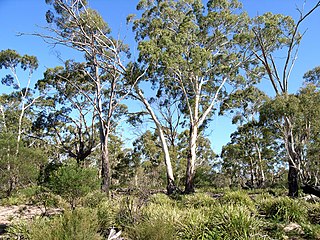
Eucalyptus viminalis, commonly known as the manna gum, white gum or ribbon gum, is a species of small to very tall tree that is endemic to south-eastern Australia. It has smooth bark, sometimes with rough bark near the base, lance-shaped to curved adult leaves, flower buds in groups of three or seven, white flowers and cup-shaped or hemispherical fruit.

Backhousia is a genus of thirteen currently known species of flowering plants in the family Myrtaceae. All the currently known species are endemic to Australia in the rainforests and seasonally dry forests of Queensland, New South Wales and Western Australia.

Eucalyptus obliqua, commonly known as messmate stringybark or messmate, but also known as brown top, brown top stringbark, stringybark or Tasmanian oak, is a species of tree that is endemic to south-eastern Australia. It has rough, stringy or fibrous bark on the trunk and larger branches, smooth greyish bark on the thinnest branches, lance-shaped to curved adult leaves, flower buds in groups of seven to fifteen or more, white flowers and cup-shaped or barrel-shaped fruit.

Eucalyptus leucoxylon, commonly known as yellow gum, blue gum or white ironbark, is a species of small to medium-sized tree that is endemic to south-eastern continental Australia. It has smooth yellowish bark with some rough bark near the base, lance-shaped or curved adult leaves, flower buds in groups of three and cylindrical, barrel-shaped or shortened spherical fruit. A widely cultivated species, it has white, red or pink flowers.
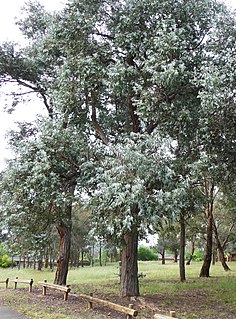
Eucalyptus cinerea, commonly known as the Argyle apple, mealy stringbark or silver dollar tree, is a species of small- to medium-sized tree that is endemic to south-eastern Australia. It has rough, fibrous bark on the trunk and branches, usually only juvenile, glaucous, egg-shaped evergreen leaves, flower buds in groups of three, white flowers and conical to bell-shaped fruit.
Beilschmiedia bancroftii is a tree species in the family Lauraceae. It is native to Queensland in Australia. Common names include yellow walnut, yellow nut and canary ash.
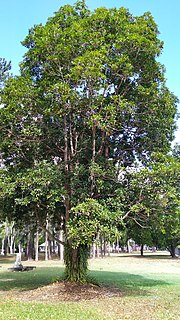
Elaeocarpus bancroftii, commonly known as Kuranda quandong, Johnstone River almond, ebony heart, grey nut, or nut tree is a large rainforest tree in the family Elaeocarpaceae which is endemic to Queensland. It has coriaceous leaves, attractive white flowers and relatively large fruit containing an edible kernel.

Amyema quandang is a species of hemi-parasitic shrub which is widespread throughout the mainland of Australia, especially arid inland regions, sometimes referred to as the grey mistletoe.

Eucalyptus bancroftii, commonly known as Bancroft's red gum or orange gum, is a species of tree that is endemic to eastern Australia. It has smooth bark, lance-shaped or curved adult leaves, flower buds usually arranged in groups of seven, white flowers and cup-shaped, conical or hemispherical fruit.
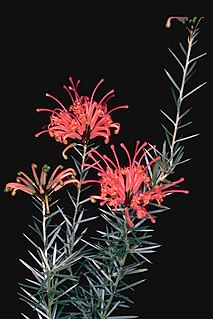
Grevillea kennedyana, also known as flame spider-flower, is a species of flowering plant in the family Proteaceae and is endemic to a restricted area of inland eastern Australia. It is an erect shrub with many branches, usually linear leaves and erect clusters of rich red flowers.
Persoonia pungens is a species of flowering plant in the family Proteaceae and is endemic to the south-west of Western Australia. It is an erect to spreading or low-lying shrub with densely hairy young branchlets, twisted elliptic to oblong, sharply-pointed leaves, and glabrous, bright yellow flowers borne in groups of up to five.
Grevillea nematophylla, commonly known as water bush or silver-leaved water bush, is a species of flowering plant in the family Proteaceae and is endemic to Australia. It is shrub or small tree with simple or pinnatisect leaves, the leaves or lobes linear, and branched, cylindrical clusters of cream-coloured flowers.

Corymbia erythrophloia, commonly known as the red bloodwood, variable-barked bloodwood, red-barked bloodwood or gum-topped bloodwood, is a species of tree that is endemic to Queensland. It has rough bark on the trunk and branches, egg-shaped or lance-shaped adult leaves, flower buds in groups of seven, creamy white flowers and urn-shaped to spherical fruit.
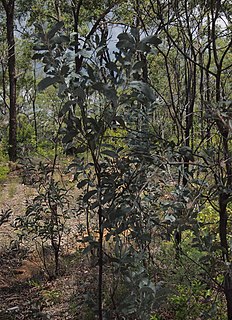
Acacia bancroftiorum, commonly known as Bancroft's Wattle, is a shrub belonging to the genus Acacia and the subgenus Phyllodineae that is native to parts of eastern Australia.
Elaeocarpus stellaris is a species of flowering plant in the family Elaeocarpaceae and is endemic to north-eastern Queensland. It is a tree, sometimes with buttress roots at the base of the trunk, elliptic to egg-shaped leaves, small groups of flowers with greenish-yellow sepals and creamy-white petals, the fruit conatining a five-flanged stone.
Triplarina bancroftii is a species of flowering plant in the myrtle family, Myrtaceae and is endemic to a restricted area of Queensland. It is a shrub with egg-shaped or elliptic leaves, flowers with five sepals and five relatively small white petals and sixteen to eighteen stamens.
Grevillea sphacelata, also known as the grey spider flower, is a species of plant in the protea family that is endemic to Australia. The specific epithet sphacelata comes from the Latin for “withered”, with reference to the appearance of the flowers.

Thomas Lane Bancroft (1860-1933) was an Australian medical naturalist. Based in Queensland, he is known for his research on mosquito-borne diseases such as filariasis, the lifecyle of the Australian lungfish, and new crop varieties.
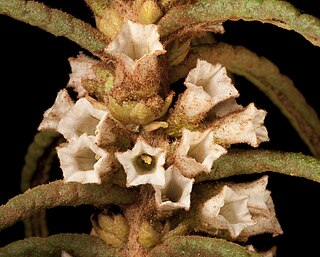
Symonanthus aromaticus is a species of flowering plant in the potato family that is endemic to Australia.













